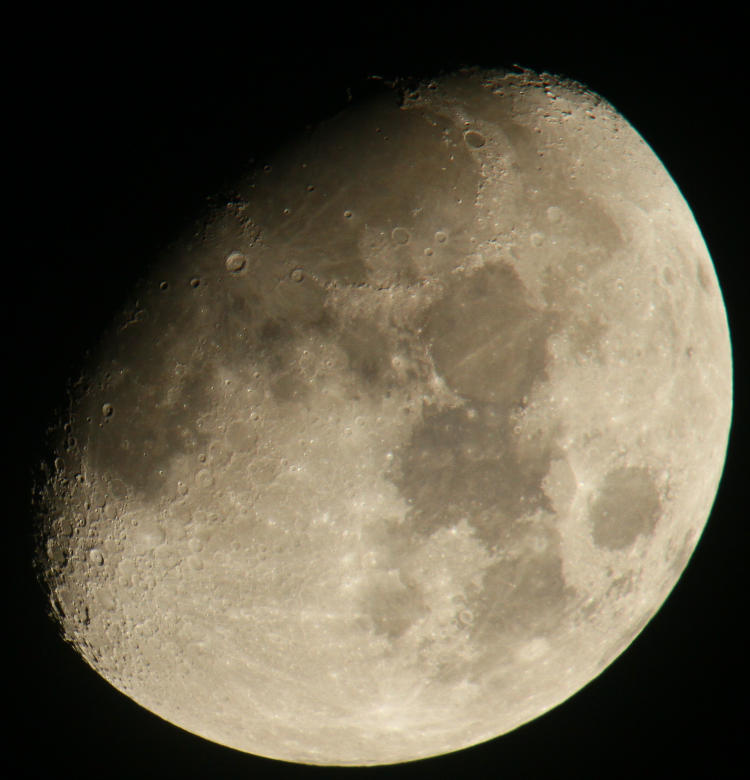Going out for something last night, I noticed the moon was sharp and in a good position up over Walkabout Studios to take advantage of, and decided to fire off a few frames. I did not, despite the previous post, bother to try for some meteor photos – that would have come much later in the night hours (technically the wee hours of the morning) as the moon dropped lower, and I had no intentions of being up then. No, this was just a casual effort to see what I brought up.
One thing about moon photography, or at least my experiences with it, is tweaking focus. For best detail the focus has to be precise, and neither the autofocus nor the manual focusing screen allows for perfect focus every time, so shooting a lot of frames while (manually) refocusing between each tends to net the best results. The difference between frame A and frame B will never show until you look at the resulting images on the computer monitor, so it’s best to get as many variations as you can while out there.
This was one of them:

Note that this is just before 11 PM EDT, so the yellowish cast isn’t from being low on the horizon, but likely from airborne particles, smoke from the west coast wildfires – there was one particular evening a few weeks back when the moon was horizon-orange while high in the sky due to this high-altitude smoke. But of course, being sized to fit the blog layout isn’t showing off enough, so we’ll go for a full-resolution fragment.

The big crater at upper right is Copernicus, the prominent one with the central peak at lower left is Tycho Maurolycus [Tycho is presently out of sight], and the one with the peak in the middle of the dark grey lunar ‘sea’ is Bullialdus (within Mare Nubium.) I’m pleased to get the erosional ‘scalloping’ of Copernicus’ edges, highlighted of course by the sun angle – timing means a lot for lunar details. Just for scale, Copernicus is about 92 kilometers across, about the north-south width of Connecticut, or the distance between Disneyworld and Cape Canaveral, or the spacing between opposing Atlanta suburbs (okay, not really – the actual drive is probably longer.) Considering that I was using the Tamron 150-600 and the Kenko 2X teleconverter, I’m not complaining. I really have to dig the telescopes out…
I also did a few video clips, and did indeed catch birds in two of them, but I’ll save them for later. For one, I rotated the lens to be aligned with the moon’s apparent movement, so it would go straight across the frame top to bottom and the terminator would be ‘level,’ and the bird cut right across dead-level with the terminator. Which looked fine in the video, but you’ll notice that the terminator is nowhere near level, and I was aiming upwards anyway (the moon was at an azimuth of roughly 35° when these were shot,) so the bird’s flight angle was far from normal-looking.
While out there, I noticed a bright ‘star’ not far from the moon, knowing from the magnitude and position it was likely a planet instead – I remembered Jupiter and Saturn would be up and close by, but not the order of them. Before it passed out of sight behind the chimney, I fired off a number of frames, at varying exposure times and ISOs, to bring out whatever detail I could with the rig, having a decent amount of success. However, the following image, while full resolution, is ‘Photoshopped,’ a digital composite that seems to be the norm for astrophotographs anymore. I’m not fond of the practice, but it illustrates something here.

That’s Jupiter of course, with four of its moons: from top to bottom, Callisto, Ganymede, Io, and Europa. However, the exposure to actually snag the moons bleached Jupiter out to a featureless white disk, so another exposure of the planet was dubbed over to show the striping. Also, I either captured Callisto extremely faintly, or motion blur from the rotation of the Earth during exposure rendered the moons into short lines, so this exposure of the moons has had the brightness brought up so Callisto was more visible and wouldn’t be lost in display.
Since the two photos immediately above, Jupiter and the crater detail one, are the same magnification at full resolution, this means that Jupiter appears roughly the size of Copernicus, and you can go out any night and see if you can discern Copernicus by eye (though it would work best if it’s near the terminator like here, to throw some distinctive shadows.) With a decent pair of binoculars, the Jovian moons can often be made out, just barely, but it takes some more serious magnification to get any kind of detail from the planets themselves.
Now, some observations that made this post take way longer than intended. It seems like Callisto at top is quite far out there, but remember that the moons are all orbiting Jupiter, in a plane roughly flat to us, so they are all likely somewhere in this ellipse and not at their maximum separation according to our perspective. For giggles, I did a bit of playing around to determine the relative distance with Earth and its moon – assuming Earth was the size of Jupiter within this image, how far out would the orbit of our moon be? And the answer is, well outside of this frame. The moon is roughly 30 Earth diameters away, and the entire frame diagonally doesn’t span 30 [Jupiter] diameters. Makes the moon landings seem a bit more impressive, doesn’t it?
So, the title is quite misleading, now that I look at it. The actual time between first and last frames last night was 29 minutes, but it’s been a lot longer than that putting all the details in this post.





















































hi
Hey